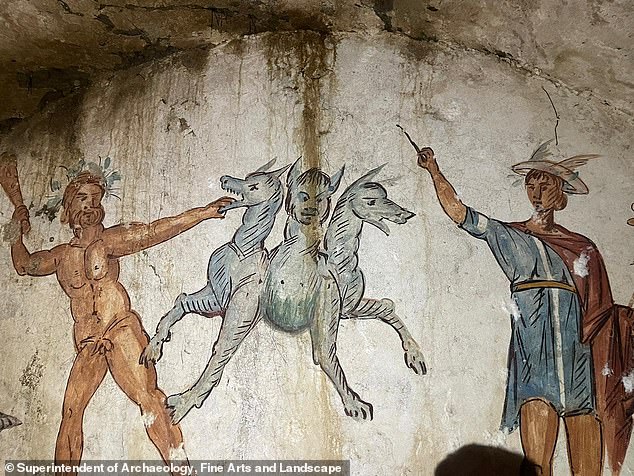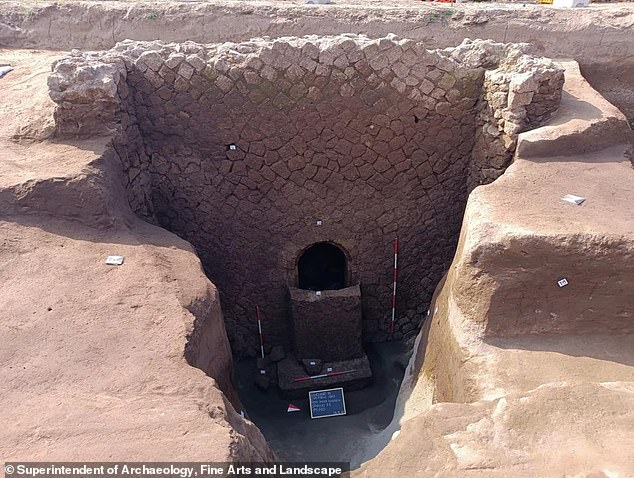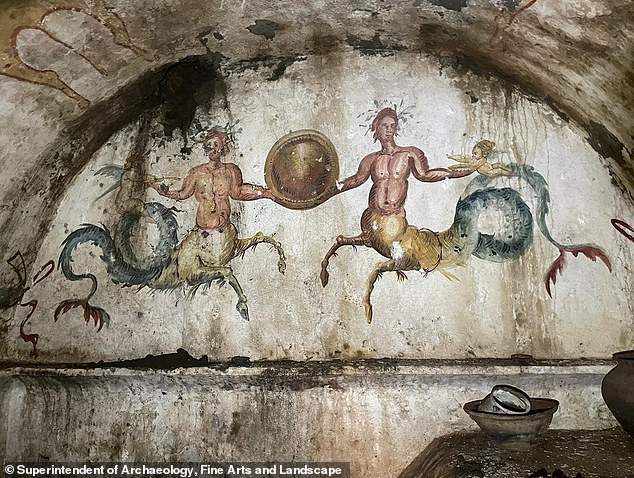A sealed tomb featuring a fresco of Cerberus – the three-headed dog from Ancient Greek mythology – has been uncovered in Italy.
The burial chamber was discovered in Giugliano, a suburb of Naples, and is believed to be some 2,000 years old.
It was found on farmland during an archaeological survey carried out prior to the start of maintenance work on the city’s water system.
Archaeologists have previously found a large number of burial sites in the same area which date from the Roman Republic era (510-31 BC) to the Roman Imperial Age (31 BC – AD 476).
The untouched tomb features a number of frescoes in largely pristine condition across its ceilings and walls.

Rare find: A sealed tomb featuring a fresco of Cerberus – the three-headed dog from Ancient Greek mythology – has been uncovered in Italy

History: The burial chamber was discovered in Giugliano, a suburb of Naples, and is believed to be some 2,000 years old. It was uncovered after archaeologists spotted a wall featuring an ancient Roman construction technique known as opus incertum
Among the most notable mythological figures depicted is that of the three-headed dog said to guard the gates of the underworld, which is why the burial chamber has been dubbed the ‘Tomb of Cerburus’.
The striking painting represents the 12th and most dangerous of the Labours of Hercules: when he descended to Hades guided by Mercury to capture the three-headed monster dog Cerberus.
Other mythological figures painted on the walls include ichthyocentaurs – a centaurine-type sea god with the upper body of a human and the lower anterior half and fore-legs of a horse and the tail of a fish.
The scene depicted shows two ichthyocentaurs facing each other while holding an ancient Greco-Roman shield.
Each has an erote – a winged Cupid-like baby associated with love and sexual desire – on their arm.
The burial chamber was discovered after archaeologists spotted a wall that had been built using an ancient Roman construction technique known as opus incertum.
It later emerged that this was the front wall of the tomb, which had been sealed with a heavy slab made of tuff — a light, porous rock created out of volcanic ash and other sediments.
To get inside the burial chamber, the archaeologists had to carefully remove the tiles covering the ceiling opening, which revealed what experts said was an ‘unprecedented’ discovery.

To get inside the burial chamber, the archaeologists had to carefully remove the tiles covering the ceiling opening, which revealed what experts said was an ‘unprecedented’ discovery

Mythology: Among the most notable mythological figures depicted are ichthyocentaurs – a centaurine-type sea god with the upper body of a human and the lower anterior half and fore-legs of a horse and the tail of a fish (pictured)
‘The tomb has frescoed ceilings and walls in perfect condition, with mythological scenes that go all around the room and figurative representations among which, a three-headed dog stands out,’ said Mariano Nuzzo, the superintendent of Archaeology, Fine Arts and Landscape for the Naples metropolitan area.
‘Three painted klìnai , an altar with vessels for libations, the deceased still placed on the funeral beds with rich objects – complete the picture of a discovery which, in this area, is unprecedented.’
Work is now continuing to excavate even more of the tomb without damaging its contents.
Nuzzo added: ‘The emotion aroused by the privilege of such a discovery is indescribable.
‘The territory of Giugliano, after years of oblivion, is finally returning significant vestiges of its glorious past, to be preserved and protected, thanks to a common effort.’





